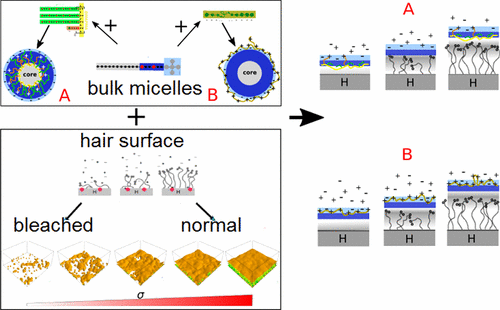当前位置:
X-MOL 学术
›
J. Phys. Chem. B
›
论文详情
Our official English website, www.x-mol.net, welcomes your
feedback! (Note: you will need to create a separate account there.)
Modeling of Polyelectrolyte Adsorption from Micellar Solutions onto Biomimetic Substrates
The Journal of Physical Chemistry B ( IF 2.8 ) Pub Date : 2017-09-12 00:00:00 , DOI: 10.1021/acs.jpcb.7b05195 Soumi Banerjee 1 , Colette Cazeneuve 2 , Nawel Baghdadli 2 , Stéphanie Ringeissen 2 , Fabien Léonforte 2 , Frans A.M. Leermakers 1 , Gustavo S. Luengo 2
The Journal of Physical Chemistry B ( IF 2.8 ) Pub Date : 2017-09-12 00:00:00 , DOI: 10.1021/acs.jpcb.7b05195 Soumi Banerjee 1 , Colette Cazeneuve 2 , Nawel Baghdadli 2 , Stéphanie Ringeissen 2 , Fabien Léonforte 2 , Frans A.M. Leermakers 1 , Gustavo S. Luengo 2
Affiliation

|
Depositing cationic polyelectrolytes (PEs) from micellar solutions that include surfactants (SU) onto surfaces is a rich, complex, highly relevant, and challenging topic that covers a broad field of practical applications (e.g., from industrial to personal care). The role of the molecular architecture of the constituents of the PEs are often overruled, or at least and either, underestimated in regard to the surface properties. In this work, we aim to evaluate the effect of a model biomimetic surface that shares the key characteristics of the extreme surface of hair and its concomitant chemo- and physisorbed properties onto the deposition of a complex PEs:SU system. To tackle out the effect of the molecular architecture of the PEs, we consider (i) a purely linear and hydrophilic PE (P100) and (ii) a PE with lateral amphiphilic chains (PegPE). Using numerical self-consistent field calculations, we show that the architecture of the constituents interfere with the surface properties in a nonintuitive way such that, depending on the amphiphilicity and hydrophilicity of the PEs and the hydrophobicity of the surface, a re-entrant adsorbing transition can be observed, the lipid coverage of the model hair surface being the unique control parameter. Such a behavior is rationalized by the anticooperative associative properties of the coacervate micelles in solution, which is also controlled by the architecture of the PEs and SU. We now expect that PEs adsorption, as a rule, is governed by the molecular details of the species in solution as well as the surface specificities. We emphasize that molecular realistic modeling is essential to rationalize and optimize the adsorption process of, for example, polymer conditioning agents in water-rinsed cosmetic or textile applications.
中文翻译:

从胶束溶液到仿生基质上的聚电解质吸附的建模
从包含表面活性剂(SU)的胶束溶液中将阳离子聚电解质(PE)沉积到表面上是一个丰富,复杂,高度相关且具有挑战性的主题,涵盖了广泛的实际应用领域(例如,从工业到个人护理)。PE的成分的分子结构的作用经常被推翻,或者至少在表面性能方面被低估了,或者至少被低估了。在这项工作中,我们旨在评估仿生表面模型的效果,该模型具有头发极端表面的关键特征及其伴随的化学和物理吸附特性,可沉积在复杂的PEs:SU系统上。为了解决PE分子结构的影响,我们考虑(i)纯线性和亲水性PE(P 100)和(ii)具有侧链两亲链的PE(PegPE)。使用数值自洽场计算,我们显示了成分的结构以非直观的方式干扰了表面性质,从而根据PE的两亲性和亲水性以及表面的疏水性,出现了凹状的吸附转变可以观察到,模型头发表面的脂质覆盖率是唯一的控制参数。通过凝聚层胶束在溶液中的抗合作缔合性质合理化这种行为,这也由PE和SU的体系结构控制。现在,我们通常期望PEs的吸附受溶液中物种的分子细节以及表面特异性的支配。
更新日期:2017-09-12
中文翻译:

从胶束溶液到仿生基质上的聚电解质吸附的建模
从包含表面活性剂(SU)的胶束溶液中将阳离子聚电解质(PE)沉积到表面上是一个丰富,复杂,高度相关且具有挑战性的主题,涵盖了广泛的实际应用领域(例如,从工业到个人护理)。PE的成分的分子结构的作用经常被推翻,或者至少在表面性能方面被低估了,或者至少被低估了。在这项工作中,我们旨在评估仿生表面模型的效果,该模型具有头发极端表面的关键特征及其伴随的化学和物理吸附特性,可沉积在复杂的PEs:SU系统上。为了解决PE分子结构的影响,我们考虑(i)纯线性和亲水性PE(P 100)和(ii)具有侧链两亲链的PE(PegPE)。使用数值自洽场计算,我们显示了成分的结构以非直观的方式干扰了表面性质,从而根据PE的两亲性和亲水性以及表面的疏水性,出现了凹状的吸附转变可以观察到,模型头发表面的脂质覆盖率是唯一的控制参数。通过凝聚层胶束在溶液中的抗合作缔合性质合理化这种行为,这也由PE和SU的体系结构控制。现在,我们通常期望PEs的吸附受溶液中物种的分子细节以及表面特异性的支配。











































 京公网安备 11010802027423号
京公网安备 11010802027423号